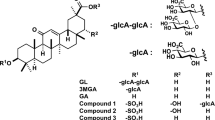Abstract
A 77-year-old man with a history of hypertension and hyperuricemia was admitted to our hospital complaining of limb weakness, persistent constipation, and worsening hypertension. He had been taking a Chinese herbal remedy for allergic rhinitis for the past 10 years, together with an angiotensin-converting enzyme inhibitor (ACE-I; enalapril, 20 mg daily). After the dosage of enalapril had been reduced to 10 mg daily about 1½ years before the current admission, he had developed persistent constipation. Therefore, he had started taking another traditional Chinese herbal remedy, a laxative, for the constipation, about 4 months prior to this hospitalization. Laboratory data on admission demonstrated marked metabolic alkalosis with severe hypokalemia associated with urinary wasting of potassium and chloride. A diagnosis of pseudoaldosteronism was made based upon his past history of exposure to various traditional Chinese medicines containing glycyrrhizin. Discontinuation of the Chinese remedies and supplementation of potassium successfully normalized the electrolyte imbalance and relieved all symptoms within a short time. The present case describes the occurrence of pseudoaldosteronism induced by a patient taking two traditional Chinese herbs, both containing glycyrrhizin, resulting in an overdose of this causative chemical agent. The development of pseudoaldosteronism appeared to be of particular interest with regard to the interaction of the renin-angiotensin-aldosterone (RAA) system with glycyrrhizin, in which an ACE-I retarded the development of pseudoaldosteronism.
Similar content being viewed by others
References
S Tanihara I Oki T Ojima Y Nakamura H Yanagawa (1999) ArticleTitleProcess and current status of the epidemiologic studies on cedar pollinosis in Japan J Epidemiol 9 20–6 Occurrence Handle10098349 Occurrence Handle1:STN:280:DyaK1M7pvVChsA%3D%3D
JW Conn DR Rovner EL Cohen (1968) ArticleTitleLicorice-induced pseudoaldosteronism JAMA 205 492–6 Occurrence Handle5695305 Occurrence Handle1:STN:280:CCeA1MzisFM%3D Occurrence Handle10.1001/jama.205.7.492
Stewart PM, Wallace AM, Valentino R, Burt D, Shackleton CHL, Edwards CRW. Mineralocorticoid activity of liquorice; 11-beta-hydroxysteroid dehydrogenase deficiency comes of age. Lancet II 1987:821–4
Y Morimoto C Nakajima (1991) ArticleTitlePseudoaldosteronism induced by licorice derivatives in Japan J Medical and Pharmaceutical Soci for WAKAN-YAKU 8 1–22
Y Fujiwara R Kikkawa K Nakata E Kitamura T Takama Y Shigeta (1983) ArticleTitleHypokalemia and sodium retention in patients with diabetes and chronic hepatitis receiving insulin and glycyrrhizin Endocrinol J 20 243–9
GJ De Klerk MG Nieuwenhuis JJ Beutler (1997) ArticleTitleHypokalaemia and hypertension associated with use of liquorice flavoured chewing gum BMJ 314 731–2 Occurrence Handle9116553 Occurrence Handle1:STN:280:ByiB38nhs1U%3D
ML Ricketts PM Stewart (1999) ArticleTitleRegulation of 11β-hydroxysteroid dehydrogenase type 2 by diuretics and the renin-angiotensin-aldosterone axis Clin Sci 96 669–75 Occurrence Handle10334975 Occurrence Handle1:CAS:528:DyaK1MXktFyqtbk%3D Occurrence Handle10.1042/CS19980353
CB Whorwood MC Sheppard PM Stewart (1993) ArticleTitleLicorice inhibits 11β-hydroxysteroid dehydrogenase messenger ribonucleic acid levels and potentiates glucocorticoid hormone action Endocrinology 132 2287–92 Occurrence Handle8504732 Occurrence Handle1:CAS:528:DyaK3sXltV2htLk%3D Occurrence Handle10.1210/en.132.6.2287
Author information
Authors and Affiliations
Corresponding author
Additional information
Some details of this case were presented at the 524th Regional Meeting of the East Chapter of the Japanese Society of Internal Medicine, in Tokyo, Japan, February 19, 2005
About this article
Cite this article
Iida, R., Otsuka, Y., Matsumoto, K. et al. Pseudoaldosteronism due to the concurrent use of two herbal medicines containing glycyrrhizin: interaction of glycyrrhizin with angiotensin-converting enzyme inhibitor. Clin Exp Nephrol 10, 131–135 (2006). https://doi.org/10.1007/s10157-006-0415-x
Received:
Accepted:
Issue Date:
DOI: https://doi.org/10.1007/s10157-006-0415-x




